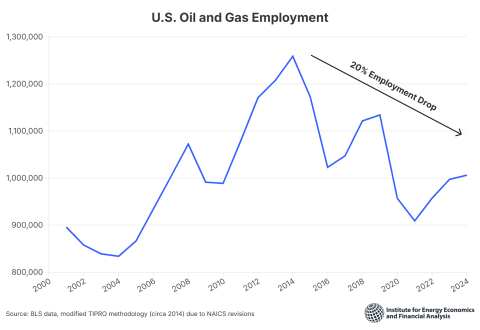Testimony to Vermont House Committee on Government Operations and Military Affairs By Tom Sanzillo
Download Full Version

Testimony to Vermont House Committee on Government Operations and Military Affairs
By Tom Sanzillo, Director of Financial Analysis
Institute for Energy Economics and Financial Analysis
On S.B. 42
April 27, 2023
Chairman McCarthy, thank you for inviting me to comment on S.B. 42.
My name is Tom Sanzillo, Director of Financial Analysis for the Institute for Energy Economics and Financial Analysis (IEEFA.org).
Background
We are a global, non-profit organization comprised of energy and financial experts working to accelerate the energy transition. Prior to my work with IEEFA, I spent 17 years in executive management positions at the New York City and State Comptroller’s Office, among the largest pension funds in the country. In both positions, I was involved at the senior management level for the various pension funds, including oversight of investment and shareholder voting policy.
Focus of the Bill
The bill asks that a plan be prepared by the Vermont Pension Investment Commission (VPIC) in 2024 that divests the state’s portfolio from fossil fuels by 2040. At each step, VPIC must determine that it is prudent to move forward. The plan would explicitly exempt private investments until such time as VPIC determines that it is fiduciarily sound to do so.
Complete divestment allows for a 2 percent de minimis exception. That is, the fund can maintain 2% of its holdings in fossil fuels. The 2 percent exception would allow investments in private equity and strengthen VPIC’s already successful engagement activities.
Commentary
The bill has been objected to on several grounds. I disagree with these objections. Opponents of the bill argue that S.B. 42 would: 1) lose money for the fund; 2) eliminate VPIC’s ability to buy into index funds; 3) prevent investments in private equity; 4) eliminate shareholder engagement; and 5) expose the board to liability.
Opponents of the bill say fossil fuel investments are a positive contributor to the value of the fund and therefore to divest would lose money.
The oil and gas industry has been a very large contributor to the asset value of pension funds for many years. However, this is no longer true.
Over the last five, 10 and 15 years, the oil and gas sector has lagged the stock market. In seven of the last 10 years leading up to the invasion of Ukraine, the industry was at or near the bottom of the stock market.
During 2021 and 2022, the sector’s fortunes improved due to the economic rebound following the worst days of the COVID-19 pandemic and the Russian invasion of Ukraine in early 2022. These two factors caused oil prices to rise dramatically. These factors are unsustainable extraordinary events that have raised oil and fossil fuel stock prices due to disruptive bottlenecks that formed. Prices rose as high as $125 per barrel.
Although the war continues, both factors have abated as drivers of oil and gas prices. Oil prices have fallen to around $80 per barrel, still high. Despite relatively high oil prices, the oil and gas industry since January 2023 has been at or near the bottom of the stock market.
Further to the point, McKinsey reports that from 2016-21, the oil and gas sector saw losses in the private equity space, even with the improvements in pricing due to COVID-19. The oil and gas sector was the only sector in the economy to see reductions in private equity activity. Those investors that did take risks were “punished.”
The faltering state of the oil and gas sector is rooted in unprecedented competition across all of its most important industries—cars, power plants and plastics.
Never before has the oil and gas sector faced the fact that a whole new industry of electric cars will put a big dent in the amount of oil and gas used for automobiles and trucks. Darren Woods, ExxonMobil’s CEO, has stated that the company will be out of the gasoline refining industry by 2040.
Never before has the natural gas industry faced the fact that a whole new industry of wind, solar and energy efficiency reduced its market share. And the International Energy Agency has stated that there is no longer any need for more natural gas fields if the world is going to meet its emissions reduction targets.
And for those who follow the coal industry, it is in a rapid decline—losing more than 50% of its production since 2007 in the United States.
Finally, the hopes of the industry for greater use of oil and gas for petrochemicals is facing economy-wide planning efforts in Europe, Asia and across the world, all seeking to reduce the amount of fossil fuels in the economy.
The United States is unfortunately one of the only large countries in the world where these powerful economic planning exercises are not taking place.
The oil and gas sector is also facing a historically unprecedented period where many of the industry leaders are also political leaders of oil dependent nations. They are desperate to maintain the flow of trillions in oil and gas revenues. Russia’s invasion of Ukraine is a large, stunning example of this new oil and gas dynamic, where geopolitics has replaced supply and demand.
The profits of the oil and gas sector are unsustainable and the industry is on shaky ground. It faces a future where it will be supplying less oil and gas to fewer consumers.
Your investment advisors are wrong when they tell you that the oil and gas sector is having a positive impact on your portfolio in the equity index or in the private equity index. It was once true, but not any longer.
My organization sees divestment as a defensive measure to prevent losses in your portfolio. Our position is rooted in financial factors that are losing value for the fund and dragging down the ability of the fund to meet its financial targets. The claim that investments in fossil fuels are in the best interest of the members of the retirement system does not comport with the industries’ return profiles or the outlook for the future.
VPIC has equated the bill with forcing the fund out of various indexes. The argument seems to be that there would be no place to invest the money if the state divested. This is an unusual statement. VPIC currently invests in a low-carbon fund—Champlain Mid Cap—an index fund that has supplied Vermont’s retirees with investment performances that exceed targets, is within a responsible fee level and helps to improve the fund’s climate goals. VPIC’s argument that it would be forced out of index funds is belied by its own portfolio. VPIC already has evidence through its investment experience with Champlain that: 1) there are fossil-free or low- carbon index alternatives available on the market, 2) they are accessible to VPIC and 3) the fees fall within budgetary parameters.
But there is more evidence that there are many fossil-free indexes on the market today and that the fees are within current budgetary parameters. VPIC’s advice to the Vermont Legislature is both misleading and wrong.
First, there are 1,500 examples of funds that have divested, including large funds and small funds; pension funds and endowments; and funds that have completely or partially divested. Do you think they have all paid exorbitant fees to achieve the goals of protecting their portfolio from continued and future fossil fuel losses?
Second, a review of several examples of fossil fuel portfolios that have divested demonstrates that returns are either positive or neutral, confirmed by a report prepared by BlackRock for the City of New York.[1] Fees were within existing budgetary ranges.
Third, the California State Teachers Retirement System (CalSTRS) recently assessed four indexes from the MSCI sustainable investments family of indexes.[2] The funds—Paris Complaint, Low Carbon, Climate Change, MSCI All Country Index excluding Fossil Fuels and a customized staff generated fund of the top 100 emitters—met CalSTRS performance standards and moved the portfolio toward its net zero strategy. CalSTRS ultimately has taken steps to move more than $20 billion in equities using one of these funds, confident in the ability of these indexes to absorb substantially larger capital allocations, to meet performance targets and maintain fees within budgetary parameters.
There are many examples on the market that reflect different approaches to divestment that are profitable, reliable and growing. Ten years ago, Vanguard, BlackRock, Fidelity, JP Morgan Chase and a host of mainstream firms had only very limited offerings in the sustainable space. Today they are quite prevalent, so much so that they are now rated. The funds are now capable of handling institutional clients.
S.B. 42 gives VPIC until 2030 to work through the issue of moving its various index funds into lower carbon funds. VPIC is currently invested in BlackRock Indexes. This same company has a portfolio of low carbon/fossil free funds that could accommodate Vermont’s needs.
There have been statements made that S.B. 42 would prevent VPIC from investing money in private equity and other private credit arrangements. S.B. 42 gives a longer time frame for divestment from fossil fuels because the investments are illiquid and any immediate sale could result in loss of value. There is a clear pathway for private equity divestment, just as there is one for equity indexes.
The City of New York recently announced that it would be informing its managers that the city no longer wished to invest private equity proceeds in oil and gas investments. This is a large fund that has vetted this issue carefully and come to a conclusion that it can safely and prudently move toward divestment. New York City will retain its existing private equity oil and gas investments and allow them to roll off the portfolio. By not investing private equity money in new oil and gas ventures, it will achieve divestment as the legacy assets reach their maturity dates and roll off.
S.B. 42 allows for continued investment in oil and gas in private equity until such time as the fund determines that it is prudent to divest. Frankly, there is an abundance of evidence to tell your managers not to invest in any oil and gas assets with private equity dollars going forward. There is also ample evidence that your fund managers should focus like a laser on existing oil and gas investments, since they are clearly distressed investments that are most likely pulling the overall private equity returns to Vermont retirees down as it is pulling down its stock returns this year. As noted above, McKinsey’s analysis tells us that the fossil fuel sector is the only sector that has not seen gains in the number and type of deals occurring over the last five years. This is because those deals, like the oil and gas sector, generally are losing money.
Beside extraordinarily poor investment performance, the oil and gas sector also poses environmental, social and governance (ESG) risks. My organization makes a strong distinction between financial risks and those attributed to ESG factors.
ESG issues are a separate and compelling set of considerations that the legislature and VPIC should follow carefully. If an investment is performing poorly financially, it is likely that its underlying ESG compliance is also weak. Oil and gas sector leaders are seen as flagrant violators of the principles of shareholder engagement. The leaders of the oil and gas sector, unlike many other sectors of the economy, treat institutional investors with disdain.
But S.B. 42 allows for (and in fact it strengthens) shareholder engagement because it gives the ultimate tool in any shareholder negotiation to VPIC staff—the goal of divestment. This approach to shareholder engagement, to use divestment as a last resort tool, is backed by the International Association of Insurance Superintendents and is also the pivotal operating assumption of the New York State Common Retirement Fund, one of the world leaders in pension funds and climate policy.
In addition, S.B. 42 allows the fund to hold a de minimis basket of fossil fuel investments, amounting to 2% in the aggregate. So it is likely to always have holdings in oil and gas companies. Furthermore, the 2% basket provision can be applied to private equity funds if VPIC believes these investments would be in the best interest of the fund.
The concern about immunity for investment staff is a fair one to raise. I do not pretend to know the actual coverage of your employees under existing statutes. However, if the coverage is so lax that employees are at risk if they make a fiduciarily sound investment decision, then that deserves an independent inquiry all of its own.
References to California’s divestment of thermal coal are important. California has made money on that divestment according to recent reports. Nevertheless, S.B. 42, by emphasizing the fiduciary duty—and requiring that each step of the way shows how the interest of the beneficiaries are put first—provides coverage beyond that of California’s protective covenants. As a former fund manager, I would take great comfort from that (unless, of course, as indicated by VPIC’s legal opinion, there appears to be a flaw in the underlying statutory coverage for VPIC employees).
At best, VPIC’s financial review of S.B. 42 submitted to the legislature is incomplete in its assessment of how divested funds could perform. It fails to disclose its own assumptions. It does not acknowledge contrary information on the market. It ignores an index fund that it has been benefiting from that is fossil-free, exceeds investment targets and charges fees within current budgetary constraints.
VPIC’s earlier 2017 study makes clear that the shift away from fossil fuels is slow but firmly rooted. That is the focus and trajectory of S.B. 42.
Thank you for allowing me to testify on S.B. 42.
[1] BlackRock. Investment and Fiduciary Analysis for Potential Fossil Fuel Divestment.
[2] See: CalSTRS. Investment Committee Item Number 3a – Open Session. August 31, 2022. Also see: CalSTRS. Item 3a CalSTRS Net Zero Strategy First Year Progress and Planning Update. August 31, 2022














